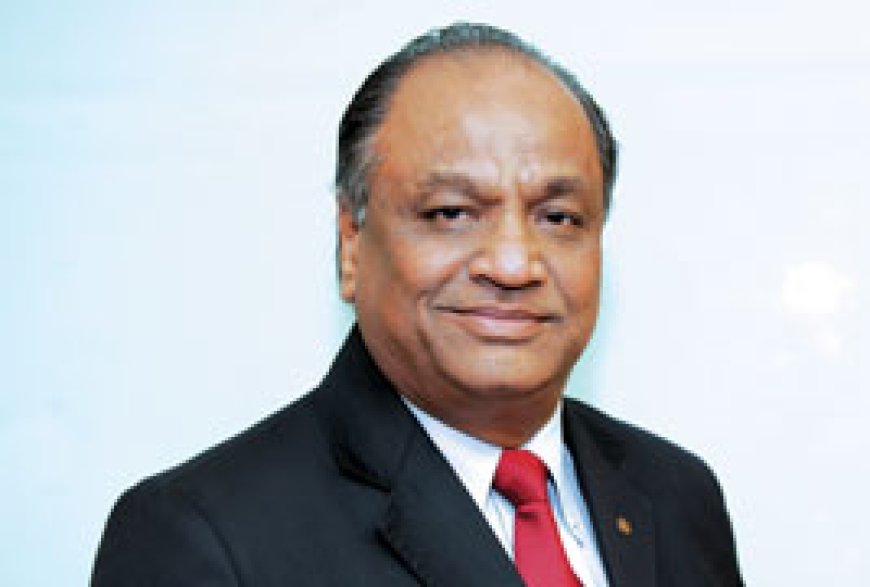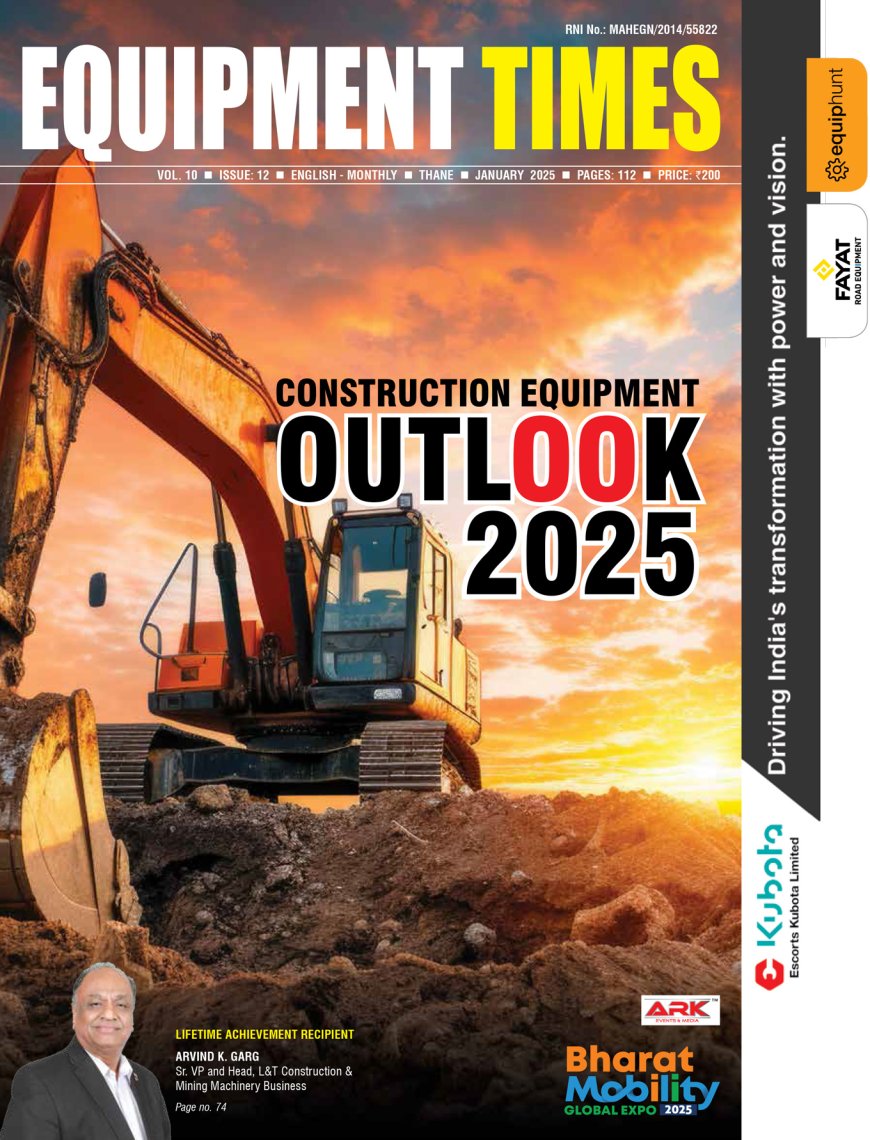We expect a strong growth for construction equipment over the next ten years.
Arvind K Garg, Executive Vice-President & Head, Construction & Mining Machinery, Larsen & Toubro Limited. Construction Equipment Manufacturers Association has been at the forefront in engaging with various ministries, national-level institutions and authorities to provide strategic inputs at the apex

Arvind K Garg,
Executive Vice-President & Head,
Construction & Mining Machinery,
Larsen & Toubro Limited.
Construction Equipment Manufacturers Association has been at the forefront in engaging with various ministries, national-level institutions and authorities to provide strategic inputs at the apex level on policy matters and technical issues affecting the Construction Equipment industry. Arvind K Garg, Executive Vice-President & Head, Construction & Mining Machinery, Larsen & Toubro Limited recently has been elected as the President of ICEMA for the term 2017-19. Garg, in an exclusive chat with EQUIPMENT TIMES throws light on the activities of ICEMA which is represented by all leading equipment manufacturers, distributors and finance companies engaged in the Indian Construction & Mining Industry, which serves the large infrastructure sector.
How do you assess the overall growth pattern of CE industry in the last couple years and what growth do you expect by 2020?
The Indian Construction Equipment industry reversed the earlier trend of shrinkage and is now registering robust growth over the last two years. The government’s impetus on infrastructure development will continue to drive the growth for the next three years and the revenues are estimated to reach US$ 22 billion by 2020. The spending on infrastructure development is likely to be 9% of the GDP in FY 17-18 as against 7.4% in FY14-15. The global market for construction equipment is expected to reach US$ 170 billion by 2020. Considering the size of our economy, the need for infrastructure development and the government’s focus on development, we can expect a strong growth for construction equipment over the next ten years in India.
Taken charge as the new President of ICEMA, what is your road map to make ICEMA a strong industry association?
ICEMA has been closely interacting with the government / ministries on a regular basis. During the course of last 5-6 years, the association has grown tremendously in terms of expanding membership strength, cooperation with the government, partnering with Indian counterpart association in other countries and focusing on policy initiatives of the government.
In the present scenario, in view of the appropriate policy initiatives taken by the Ministry of Road Transport & Highways, the construction equipment industry has experienced growth in demand of road construction equipment during last 5-10 months. Some of the equipment has registered 30-35% growth in the recent times. We are hopeful that this trend would continue to sustain in the next 2-3 years. Industry is certainly looking for business opportunities from other segments such as real estate, railways, mining, irrigation projects, etc. We are confident that government’s initiatives in these areas will help in driving demand from these segmentsand generate healthy demand of equipment for various infra projects Today, ICEMA represents the interests of over 64 companies who are manufacturers of construction equipment, component manufacturers of construction equipment and financial institutions that finance the CE industry. Through our different panels, ICEMA works closely with the government and other regulatory bodies that will support the growth of the industry and support India’s economic growth policy. ICEMA has been submitting recommendations on various issues such as setting the timeline for the next level of emission norms, reducing the GST rate from 28% to 18%, creating a regulatory framework on construction, earthmoving, mining and mineral processing equipment, setting up an independent test centre for construction equipment industry, etc. We are happy that some of our recommendations have been considered favourably by the government.
The ECE industry in India is quite mature now. I am sure the industry’s good performance would definitely impact on the policy initiatives of the government.
In the current scenario, only the road sector is firing, and many other sectors still not active which has impacted the quality of growth. What is your take on this?
Though the road sector is one of the fastest growing sectors, there is a significant drive for development in the sectors of low cost housing, railways, irrigation, airports and urban infrastructure. The road construction which was just around 7.5 km per day of highways in FY14-15 has now risen to close to 27 km per day. Under the Pradhan Mantri Gram SadakYojana (PMGSY), 133-km of road per day was constructed in 2016-17 as against a 2011-14 average of 73-km per day. It is expected to be better this year.
The railway new rail track laying has also increased sharply last year to 7 km per day and is expected to be 9.5 km per day for the current fiscal year.
In the irrigation sector, under AIBP and CADWM programs – 97 lakh hectares of land to be irrigated by 2018-19. Of the 99 projects undertaken till FY18-19, 22 have already been completed and the others are also on fast track. The Ministry of Urban Development has approved investment of Rs 2,863 crore in six states under the Atal Mission for Rejuvenation and Urban Transformation (AMRUT) scheme, for improving basic urban infrastructure over FY 2017-20.Airports Authority of India (AAI) plans to increase its capital expenditure to Rs 2,500 crore in FY17-18, primarily to expand capacity at 12 airports to accommodate increase air traffic. All these sectors are likely to generate a positive demand for construction equipment.
What is the impact of demonetization and the roll out of GST on OEMs, and on the growth prospects on the CE Industry, short term and on the long term?
The demonetization had a very short term effect on the CE industry but obviously, the long term benefits of cashless business are much higher in this sector.The GST roll out has definitely impacted the pricing of construction equipment where the equipment costs have jumped up by 10%. We have represented to the government on the challenges of the higher taxation and are awaiting a favorable support. In the short term this has affected the market volumes. Going forward, we will have to await the GST Council’s response to our request to rationalizing the GST to measure the long term impact.
On-road equipment has to follow all the rules of the CMVR. All this equipment should also have an ARAI certification. OEMs had a tough time during the latest implementation of emission norms. Is there any move to come out with a separate set of standards for on-road / of road equipment?
The CMVR norms for construction equipment had been declared well in advance and many OEMs had made adequate preparations for the same. It is important to reduce emissions to ensure we do our part to protect the environment. The Ministry of Road Transport & Highways has recently issued a Gazette Notification notifying the timelines for the next stage of emission norms for construction equipment vehicles. The draft notification has been put on the Ministry’s website inviting views and comments from all stakeholders / equipment manufacturers.
The time line set by the Ministry, as per the notification for the revised norms is 1st October 2020 for Bharat Stage IV and 1st October 2023 for Bharat Stage V. ICEMA’s Technical Panel has been interacting with Indian Diesel Engine Manufacturers’ Association (IDEMA) on Industry’s preparedness to this timelines and to recommend industry’s suggestions to the government. ICEMA has been interacting with ARAI and the Ministry of Road Transport & Highways on a regular basis and submitting industry’s viewpoints/ recommendations on specific rules of CMVR and standards of various equipment. ICEMA has also represented on the Standards Committee of Bureau of Indian Standards for setting various standards of specific equipment. Government is expected to bring out the new and revised standards for on road equipment. The proposed CEMM Act, which is under discussion with various stakeholders, would take care of the standardsfor off-highway equipment.
ICEMA, working closely with the DHI has brought out a draft of CMM. What is the progress in this area? When this is going to be implemented and what will be the benefits for the OEMs and the end-user segments?
ICEMA had a series of meetings with the Department of Heavy Industry during the course of last 2 years for creating a regulatory framework for off-highway equipment. In this connection, ICEMA’s Technical Panel has submitted its views and recommendations for incorporating the same in the CEMM Act. The Department of Heavy Industry has engaged PLR Chambers for preparing the draft CEMM Bill. The final draft was put up on DHI’s website inviting views and comments from all stakeholders. DHI would circulate the draft bill to various Ministries (including Lay Ministry) for their views. It is expected that the draft bill would be placed before Parliamentin one of the forthcoming sessions.
ICEMA Technical Panel has been interacting with Ministry of Road Transport &Highways regarding registration of various categories of equipment under e-vahan implementation. What is the progress in this area?
All equipment manufacturers (ICEMA Members) have registered their equipment successfully under e-vahan. In this connection, ICEMA organized a training programme for the equipment manufacturers for highlighting the procedures for registration of equipment under e-vahan.
Compared to the automobile industry where reliable data is provided by the members, the CE industry still seems to be opaque in this area. Is there any move to bring transparency through the TheMarket Data & Statistics Panel of ICEMA in this area?
Various ICEMA members are sharing their sales numbers for a month,in the subsequent month after the month closing. We, therefore, have fairly correct data for the CE industry and a monthly report is being shared with all the ICEMA members. Also, we are regularly bringing in reports on the industry for the ICEMA members. Any additional market data /statistical forecasting requirements by the members will be taken up as and when it is necessary. We have a panel that oversees data collection and sharing – they are exploring means to improve the same based on members’ feedback.
Also tell us the progress in setting up the test centre near Indore, Madhya Pradesh?
As per the decision taken at the Development Council Meeting for construction equipment industry held in January 2017, a team of 4-5 members of ICEMA and a representative from the Department of Heavy Industry visited BEML Kolar centre, HEC Ranchi, NATRIP, Indore and ARAI Pune to see the facilities available at their respective centre for setting up an independent test centre for the construction equipment industry. After evaluating the facilities available at these sites, we are in discussions with DHI to finalize the location for the test centre. I am hopeful that we will be able to finalize the location at the earliest.
Technology adoption comparatively is pretty slow in India. For example there are many innovations brought in by OEMs such as intelligent compaction. What role can ICEMA play to bring in / updating specification with regard to equipment that may facilitate the use of advanced construction technologies? What are the challenges?
Today most of the excavators, backhoe loaders and other road making machinery are equipped with telematics. The introduction of such technologies was a little late in India, but once the customers started realizing the value they get out of such information communication technology tools, this is becoming very popular. We manufacturers are working towards bringing in innovative solutions for better asset management for the Indian customers. Once customers see a value addition for them, it will definitely get better acceptance. A large number of the ICEMA members are multinationals and they manufacture equipment meeting high quality standards to address specific requirement by the infrastructure projects. ICEMA has been closely interacting with MoRTH, BRO, NRRDA, etc., on specific requirement of equipment and technology for their projects. Indian construction equipment has the capacity and capability to provide state-of-the art technology and equipment for infrastructure projects in India.
What is ICEMA road map on catalyzing the growth in the north-east sector?
North East India, covering 8% of India’s land and 3.1% of India’s population is the country’s gateway to South East Asia. The region has great potential for development, providing a self-sustaining economy and could well become the growth engine that will give the next big growth wave to the Indian economy. There has been a lot of emphasis on the development of North East Region over the last decade and this continues under current government as well. The Central budget allocated to the region for the year 2017-18 is INR 43,285 crores.
ICEMA with CII organized CONMAC exhibition in 2015 and 2017 focusing on various categories of equipment and technology required for infrastructuredevelopment in North East Region. There have been good opportunities for the equipment manufacturers for supplying their products in NE projects.
Hits: 69










